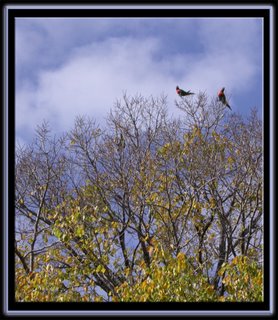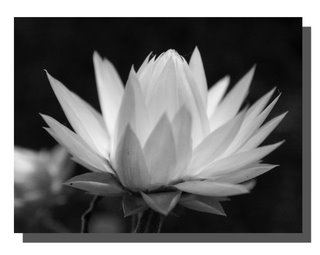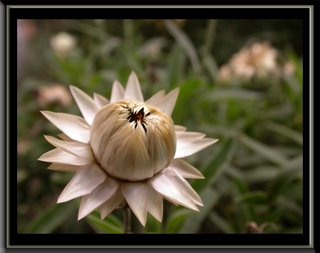Wednesday 31 May 2006
Tuesday 30 May 2006
Monday 29 May 2006
Broken Rest
Sunday 28 May 2006
Saturday 27 May 2006
Flamingo

A picture of flamingo? Shot in Gold Coast Dream World. The red, brown and green colour makes a nice combination.
One-legged Pose
Flamingos are known to stand on one leg whilst sleeping. This is done in order to minimize body heat escaping into the water in which their feet are submerged.
Flamingos were native to Australia 20 million years ago.
(courtesy wikipedia.com)
Friday 26 May 2006
Koala

The word 'koala' means "animal that does not drink" and, plus the above-mentioned reference about this. The Koala actually does drink water, but only rarely, due to its diet consisting of eucalyptus leaves, which contain sufficient water to obviate the need for the Koala to climb down for a drink.
Sometimes called the Koala Bear, although it is not part of the bear family and the name 'bear' is a misnomer. It is a generally silent creature, but males have a very loud advertising call that can be heard from almost a kilometre away during the breeding season. There is little reliable information about the lifespan of the Koala, but in captivity they have been observed to reach the age of 15 years.
A baby Koala is referred to as a joey and is hairless, blind, and earless. At birth the joey, only the size of a jelly bean, crawls into the downward-facing pouch on the mother's belly (which is closed by a drawstring-like muscle that the mother can tighten at will) and attaches itself to one of the two teats. Young remain hidden in the pouch for about six months, only feeding on milk. During this time they grow ears, eyes, and fur. The joey then begins to explore outside of the pouch. At about 30 weeks it has begun to eat the semi-liquid form of the mother’s excrement called "pap". The baby Koala will remain with the mother for another six months or so, riding on her back, and feeding on both milk and gum leaves until weaning is complete at about 12 months of age. Young females disperse to nearby areas at that time; young males often stay in the mother's home range until they are two or three years old.
The Koala was hunted almost to extinction in the early 20th century, largely for its fur. In recent years, some colonies have been hard hit by disease, especially chlamydia.
(courtesy wikipedia.com)
Thursday 25 May 2006
Mr Sunshine

Allergy to pollen is called hay fever. Generally pollens that cause allergies are those of anemophilous, because the lightweight pollen grains are produced in great quantities for wind dispersal. Breathing air containing these pollen grains brings them into contact with the nasal passages.
(courtesy wikipedia.com)
Wednesday 24 May 2006
Tuesday 23 May 2006
Crown

Shot outside Crown. The left side is the vertical fountain. Casino, lavish, wealth, but still there are so much emptiness in the sky.
Crown Casino
The Crown Casino includes two hotel towers, a number of exclusive fashion stores, top class restaurants, food courts, cinema complex and more. A notable feature is its entrance, commonly known as the 'light room', this enormous hall, situated at the entrance to the complex, boasts a sound and picture display under the themes of the four seasons.
Crown provides several traditional casino games including Blackjack, Baccarat, and Roulette but it was also the founder of an electronic version of Roulette known as Rapid Roulette. Rapid Roulette is essentially the same as traditional roulette but rather than players placing bets on a layout, all gaming takes place on a personal electronic touch screen connected to a central roulette wheel. The benefit of this is that the player has easy access to the entire betting layout, and due to the electronic nature of the game, it is both fast and accurate. Rapid Roulette has been in use for several years, and recently Rapid Bigwheel and Rapid Sicbo have been developed. There are currently plans for a workable Rapid Blackjack model.
Crown Casino is a popular destination for youth, as the complex incorporates several nightclubs, fast food restaurants and youth oriented shops and is home to a popular electronic games arena, Galactic Circus. Crown Casino is a unit of the Australian media conglomerate PBL.
(courtesy wikipedia.com)Monday 22 May 2006
Gloomy Gloomy Day

Leeper Building (Alexander Leeper was the first warden of Trinity) & it is the oldest at Trinity
College - from 1875 - & the first ever college building in Melbourne.
(Courtesy of Tamar Lewit)
Lecturer in Charge, History of Ideas in Trinity College
Note: Sold for A$15 in October 2006
Sunday 21 May 2006
Saturday 20 May 2006
Friday 19 May 2006
National Gallery of Victoria
Taken outside NGV at night. Used long exposure to get the silky fountain.
The National Gallery of Victoria is an art gallery and museum in Melbourne, Australia. Founded in 1861, it is the oldest and the largest public art gallery in Australia.
At that time the gallery began, Victoria had been an independent colony for just ten years, but in the wake of the gold rush it was easily the richest part of Australia, and Melbourne the largest city. Generous gifts from wealthy citizens, notably industrialist Alfred Felton, made it possible for the National Gallery to begin buying a large collection of overseas works from both old and modern masters.
Picasso theft
A famous event in the history of the gallery was the theft of Pablo Picasso's painting "Weeping Woman" in 1986 by a person or group who identified themselves as the "Australian Cultural Terrorists". The group took the painting to protest the perceived poor treatment of the arts by the state government of the time and sought as a ransom the establishment of an art prize for young artists. The painting was returned in a railway locker a week afterwards.
(courtesy wikipedia.com)
Thursday 18 May 2006
Leaves Passage

Trinity College is the oldest residential college of the University of Melbourne, Australia, and was founded in 1872 on a site which had been granted to the Church of England. Situated to the north of the university, Trinity's various ivy-clad stone buildings surround a large lawn known as the Bulpadok.
The college was affiliated with the university in 1876, and the Trinity Theological School was founded in 1877. With the establishment of the Trinity Women's Hostel (later to become Janet Clarke Hall) in 1886, Trinity admitted women as resident students, making it the first university college in Australia to do so.
The college's main buildings were built as follows:
- 1870: "Provost's Lodge", now the Leeper Building
- 1878: Bishops' Building
- 1880: Dining hall
- 1883-87: Clarke Building
- 1914-17: Horsfall Chapel
- 1933: Behan Building (named after former warden John Clifford Valentine Behan)
- 1958: The Memorial Building (Jeopardy)
- 1963-65: Cowan Building
- 1995-96: Burge Building
In 1989, the Trinity College Foundation Studies Program was set up to prepare international students for entry to university courses. Foundation Studies presently caters to over 800 students, although they do not live on campus.
Trinity College has a Choir which sings for services in the Chapel and around Melbourne, and tours internationally. The Choir has made a number of radio broadcasts and CD recordings.
Famous alumni
Famous Alumni include
- Sir Rupert Hamer (Victorian Premier 1972-1981)
- The Right Hon Richard Gardiner Casey (Governor General 1965-1969)
- The Right Rev Dr Peter Hollingworth (Governor General 2001-2003)
- Poet Michael Thwaites
- Historian Manning Clark
- Historian A.G.L. Shaw
- Film Director Rob Sitch
- The Most Rev Dr Peter Carnley (Archbishop & Primate of the Anglican Church of Australia 2000-2005)
- The Most Rev Dr Philip Aspinall & Primate of Australian Anglican Church 2005-
Note: Sold with 6 other pictures for a total of A$50
Wednesday 17 May 2006
Round Flower
Tuesday 16 May 2006
Silver Gull

Shot during the short break on the way to Norval Camp. We were feading these gull the disgusting vegetarian sandwhiches that we got as we were the last few to take.
Gull
Their plumage is usually white with gray or black markings on the back, wings, and head. Their long, narrow wings are adapted to soaring and their webbed feet to swimming. They have strong bills, hooked at the end; they eat clams and fish and sometimes insects, but are most useful as scavengers in harbors and bays. They are often seen hovering over the wakes of ships, seeking refuse, and frequenting garbage dumps.
(courtesy thefreedictionary.com)
Monday 15 May 2006
Great Wall of China Ranges

Great Wall of China
The Great Wall of China (Simplified Chinese: 万里长城; Traditional Chinese: 萬里長城; Pinyin: Wànlĭ Chángchéng; literally "10,000 Li¹ long wall") is a Chinese fortification built from 3rd century BC until the beginning of the 17th century, in order to protect the various dynasties from raids by Mongol, Turkic, and other nomadic tribes coming from areas in modern-day Mongolia and Manchuria. Several walls were built since the 3rd century BC, the most famous being the Great Wall built between 220 BC and 200 BC by the First Emperor, Qin Shi Huangdi, which was located much further north than the current Great Wall of China built during the Ming Dynasty, and little of it remains. The Wall stretches over a formidable 6,352 km (3,948 miles).
From outer space
There is a long standing disagreement about how visible the wall is in space.
Richard Halliburton's 1938 book Second Book of Marvels said the Great Wall is the only man-made object visible from the moon, and a "Ripley's Believe It or Not" cartoon from the same decade makes a similar claim.
The distance from Earth to the moon is about a thousand times greater than the distance from the earth to a spacecraft in near-earth orbit. If the Great Wall were visible from the moon, it would be easy to see from near-earth orbit. In fact, from near-Earth orbit, it is barely visible, and only under nearly perfect conditions. And it is no more conspicuous than many other manmade objects.
Astronaut William Pogue thought he had seen it from Skylab but discovered he was actually looking at the Grand Canal near Beijing. He spotted the Great Wall with binoculars, but said that "it wasn't visible to the unaided eye." An Apollo astronaut said no human structures were visible at a distance of a few thousand miles. U.S Senator Jake Garn claimed to be able to see the Great Wall with the naked eye from a space shuttle orbit in the early 1980s, but his claim has been disputed by several professional U.S. astronauts. Chinese astronaut Yang Liwei said he couldn't see it at all.
These inconsistent results suggest the visibility of the Great Wall depends greatly on the seeing conditions, and also the direction of the light (oblique lighting increasing the angular size of the Wall through the addition of a shadow to the physical width of the Wall). Features on the moon that are dramatically visible at times can be undetectable on others, due to changes in lighting direction. The Great Wall is only a few meters wide — sized similar to highways and airport runways — and is about the same color as the soil surrounding it.
(courtesy wikipedia.com)Sunday 14 May 2006
Never too perfect

Candle
A candle is a light source usually consisting of an internal wick which rises through the center of a column of solid fuel. Prior to the mid 19th century, the majority of candles were tallow (a byproduct of beef fat rendering). The fuel now is nearly always some form of wax, with paraffin wax being the most common. Soy and vegetable-based candles are also available, however.
Prior to the candle being ignited, the wick is saturated with the fuel in its solid form. The heat of the match or other flame being used to light the candle first melts and then vaporizes a small amount of the fuel. Once vaporized, the fuel combines with oxygen in the atmosphere to form a flame. This flame then provides sufficient heat to keep the candle burning via a self-sustaining chain of events: the heat of the flame melts the top of the mass of solid fuel, the liquified fuel then moves upward through the wick via capillary action, and the liquified fuel is then vaporized to burn within the candle's flame.
The burning of the fuel takes place in several distinct regions (as evidenced by the various colors that can be seen within the candle's flame). Within the bluer, hotter regions, hydrogen is being separated from the fuel and burned to form water vapor. The brighter, yellower part of the flame is the remaining carbon soot being oxidized to form carbon dioxide.
(courtesy wikipedia.com)Saturday 13 May 2006
Bud
Friday 12 May 2006
Macro Rose

A Rose
by Elizabeth
A lovely rose with petals softA scent so sweet and light
So beautiful a flower
With colors shining bright.
But something not so savory
About the fragrant rose -
The thorns, so sharp upon the stem,
That sharpen as it grows.
Yet still lovely is the flower
Despite the thorns that prick
Just as life and love are sweet
They too have thorns that stick.
But do not fear to live or love,
Life's not exempt from pain -
So pick a rose, you may get hurt,
But you will also gain!
(courtesy netpoet.com)
The beauty of rose cannot be denied, however, the thorns make them uncongenial.
But is not that is how life is, there are ups and down.
So why not take life as daring as how you take a rose which has thorns.
And you will realise the reap in life!
Thursday 11 May 2006
Parrot
Parrot

Sound imitation
Many species can imitate human speech or other sounds, and at least one researcher, Irene Pepperberg, has made controversial claims for the learning ability of one species; an African Grey Parrot named Alex has been trained to use words to identify objects, describe them, count them, and even answer complex questions such as "How many red squares?" (with over 80% accuracy). Other scholars claim that parrots are only repeating words with no idea of their meanings and point to Pepperberg's results as being nothing but an expression of classical conditioning.
(courtesy wikipedia.com)THE PARROT SITS
by TU FU ©
The parrot sits
Upon his perch
Wrapped in gloomy thought.
And dreams
Of his distant home.
His wings of bright blue
Are clipped;
From his red beak
Come words of wisdom.
Will they never, never
Unlatch his cage
And set him free once more?
Impatient, in anger
He claws and tears at his perch
To which he has clung
So long.
Will the world of men
Not Pity him,
And freedom he has lost?
Of what use to him in prison
Is his coat of wondrous hue?
(courtesy theparrotsocietyuk.org)
Wednesday 10 May 2006
White Flower
Tuesday 9 May 2006
Nobbies

Monday 8 May 2006
Hard disk
Sunday 7 May 2006
Magpie

The magpies are medium to large, often colorful and noisy passerine birds of the crow family, Corvidae. They are closely allied to the jays and treepies. The names 'jay', 'treepie' and 'magpie' are to a certain extent interchangeable, not reflecting any genuine genetic difference between the groups.
(courtesy wikipedia.com)
Saturday 6 May 2006
Cougar

The puma (Puma concolor since 1993, previously Felis concolor) is a type of feline (cat) found in North, Central, and South America. Though large in size this cat cannot roar, but instead purrs and has even been said to make eerily humanlike screams when courting. It is more closely related to the common house cat than to the African lion. It is also known by the regional names of cougar, mountain lion, panther, catamount, American lion, Mexican lion, Florida panther, silver lion, brown tiger, deer tiger, ghost cat, mountain screamer, Indian devil, sneak cat, king cat, ghost cat, and painted cat. The word puma comes from the Quechua language. In Brazil it is also known as suçuarana, from the Tupi language, but also has other names. In fact in the English language the puma has over 40 different names.
Pumas are tawny-colored with black-tipped ears and tail. The puma can run as fast as 50 km/h (30 mph), jump 6 m (20 ft) from a standing position, vertically leap 2.5 m (8 ft), and often weigh more than 70 kg (150 lb). Their bite strength is more powerful than that of any domestic dog. Puma claws are retractable and they have four toes. Adult males may be more than eight feet long (nose to tail), and have a mass of about 70 kg (weigh approx 150 lb). In exceptional cases males may reach as much as 90 kg. Adult females can be 2 m (7 ft) long and have a mass of about 35 kg (weigh approx 75 lb). Puma kittens have brownish-blackish spots and rings on their tails. Their life span is about a decade in the wild and 25 years or more in captivity.
Pumas that live closest to the equator are the smallest, and increase in size in populations closer to the poles.
(courtesy wikipedia.com)Friday 5 May 2006
Chain Of Law

Built : 1854 - 1970
Built in the Victorian period in the Neo-Gothic style
Notable architectural features :
The Law School Building and Old Quadrangle is architecturally significant as a stylistic demonstration of the Universitys close links with British universities in the mid-nineteenth century. The use of the Gothic revival style was a clear demonstration of this association and was expressed through such elements as the quadrangle form, castellated parapets, cloisters, bayed windows, and pinnacled and gabled parapet ends.
Building design by : F.M White(courtesy of walkingmelbourne.com)
Thursday 4 May 2006
Twisted and Tangled
Wednesday 3 May 2006
Pimplish Rose

Symbolism
Roses come in a variety of hues, each with a different symbolic meaning:- Red: love
- Pink: grace, lesser feelings of love
- Dark Pink: gratitude
- Light Pink: admiration, sympathy
- White: innocence, purity, secrecy, friendship, reverence and humility.
- Yellow: Yellow roses generally mean dying love or platonic love. In German-speaking countries, however, they can mean jealousy and infidelity.
- Yellow with red tips: Friendship, falling in love
- Orange: passion
- Burgundy: beauty
- Blue: mystery
- Green: calm
- Black: slavish devotion (as a true black rose is impossible to produce)
- Purple: protection (paternal/maternal love)
Note: Sold with 6 other pictures for a total of A$50
Tuesday 2 May 2006
Autumn Come To University
Monday 1 May 2006
Way To Autumn

The University of Melbourne, located in Melbourne, Victoria, is the second oldest university in Australia, after the University of Sydney. The oldest and main campus is in Parkville, an inner suburb of Melbourne just north of the city centre. Other campuses in Melbourne and rural Victoria have been acquired through amalgamation with smaller colleges of advanced education. It is a member of Australia's "Group of Eight" lobby group.
The University of Melbourne is one of the most prestigious universities in Australia according to several international indices. In 2005, the University of Melbourne ranked nineteenth in The Times Higher Education Supplement's list of the world's best universities, the highest rank of any Australian university. It also ranked eighth in the world for arts and humanities, and tenth for biomedicine.
The University has almost 40,000 students, who are supported by nearly 6,000 staff members (full or part-time). On November 15, 2005, Vice-Chancellor Glyn Davis announced plans for the university to adopt a system of education similar to the United States tertiary system where students earn a generalised bachelor's degree in three years and then specialise by attaining graduate qualifications in area such as law or medicine. The plan would be introduced over ten years, and is likely to see the total number of students attending the university drop to 30,000 students.

















